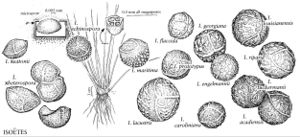Isoëtes echinospora
Bull. Soc. Bot. France 8:164. 1861.
Plants usually aquatic, occasionally emergent. Rootstock nearly globose, 2-lobed. Leaves ± deciduous, bright green to reddish green, pale toward base, spirally arranged, to 25(–40) cm, pliant, gradually tapering toward tip. Velum covering less than 1/2 of sporangium. Sporangium wall ± brown-streaked. Megaspores white, 400–550 μm diam., echinate with thin, sharp spines; girdle obscure. Microspores gray to light brown in mass, 20–30 μm, smooth to spinulose. 2n = 22.
Phenology: Spores mature in late summer.
Habitat: Emergent or in shallow, cool, oligotrophic water of slightly acidic lakes, ponds, and streams
Distribution

Greenland, Alta., B.C., Man., N.B., Nfld. and Labr. (Nfld.), N.W.T., N.S., Nunavut, Ont., P.E.I., Que., Sask., Yukon, Alaska, Calif., Colo., Conn., Idaho, Maine, Mass., Mich., Minn., Mont., N.H., N.J., N.Y., Ohio, Oreg., Pa., R.I., Utah, Vt., Wash., Wis., circumboreal.
Discussion
North American plants of Isoëtes echinospora, which bear stomata, have been called I. muricata or I. echinospora var. braunii to distinguish them from European plants of I. echinospora, which do not have stomata.
Isoëtes echinospora is a distinct species but has considerable variation, especially in size, color, and form of leaves. It is the most commonly encountered quillwort in oligotrophic, noncalcareous lakes and ponds of northeastern North America.
Isoëtes echinospora hybridizes with I. bolanderi; I. engelmannii [ = I. x eatonii Dodge (later synonym = I. x gravesii A. A. Eaton)]; I. lacustris [ = I. x hickeyi Taylor & Luebke]; I. maritima; I. riparia [ = I. x dodgei A. A. Eaton]; and I. tuckermanii.
Selected References
None.
